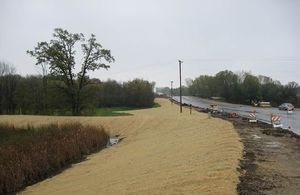
Category:Level 2 - Best management practices/Construction practices
Construction practices can be divided into erosion prevention and sediment control practices.
- Erosion prevention practices are designed to prevent or minimize erosion. Typical erosion prevention practices involve one or more of the following.
- Planning approaches that minimize the size of the bare soil area and the length of time disturbed areas are exposed to the elements – especially for long, steep slopes and easily erodible soils
- Diverting or otherwise controlling the location and volume of run-on flows to the site from adjacent areas
- Keeping concentrated flows in ditches stabilized with vegetation, rock, or other material
- Covering bare soil with vegetation, mulch, erosion control blankets, turf reinforcement mats, gravel, rock, plastic sheeting, soil binder chemicals, etc.
- Sediment control practices are designed to prevent or minimize loss of eroded soil at a site. Typical sediment control practices focus on the following.
- Physical filtration of sediment by trapping soil particles as water passes through a silt fence, drop inlet screen, fiber roll, etc.
- Settling processes, that allow sediment to fall out of flows that are slowed and temporarily impounded in ponds, traps, or in small pools created by berms, silt fencing, inlet protection dikes, check dams, and so on.
This page (Category) contains links to subcategories and pages that provide information on construction practices.
Subcategories
This category has the following 4 subcategories, out of 4 total.
L
- Level 3 - Best management practices/Construction practices/Erosion prevention practices
- Level 3 - Best management practices/Construction practices/Fact or summary sheet
- Level 3 - Best management practices/Construction practices/Sediment control practices
- Level 3 - General information, reference, tables, images, and archives/Tables/Construction stormwater
Pages in category "Level 2 - Best management practices/Construction practices"
The following 5 pages are in this category, out of 5 total.
1
A
B
G
W
Media in category "Level 2 - Best management practices/Construction practices"
The following 10 files are in this category, out of 10 total.
- Construction-Stormwater-Permit-Small Lot.pdf ; 14.29 MB
- Erosion and sediment control.pdf ; 5.52 MB
- Inlet protection.pdf ; 643 KB
- Mats and blankets.pdf ; 581 KB
- Minimizing clearing.pdf ; 634 KB
- Pipe slope drain.pdf ; 355 KB
- Sediment traps.pdf ; 485 KB
- Silt fence.pdf ; 313 KB
- Stabilized construction entrance.pdf ; 504 KB
This page was last edited on 17 November 2022, at 19:48.
